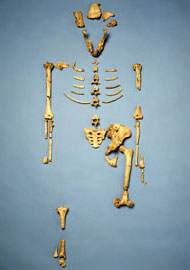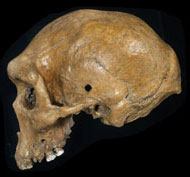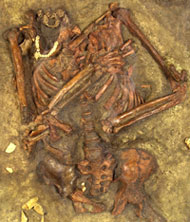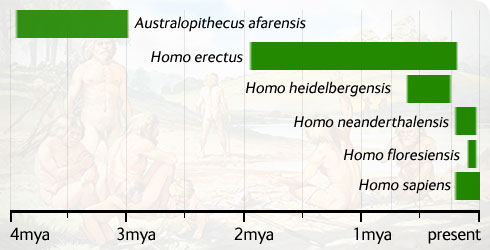Early beginnings of modern humans
The record of human evolution extends back more than 6 million years, to the point when our lineage split from that of chimpanzees, our closest living relatives. Although Homo sapiens is the only surviving human species, we are part of a large human family tree. The fossil record has so far revealed evidence for more than 20 species of ancient human relatives (hominins).
Modern humans have a number of distinctive physical features including:
- large brain volume
- relatively lightly built skeleton, adapted to walking on 2 legs
- skull with a short base and a high braincase. When viewed from behind, the braincase is narrower at the base and wider at the top.
- small or absent brow ridge
- chin on the lower jaw
Who were our early relatives?
We know about some of our early relatives because of fossil evidence, and our understanding of our family tree grows as new fossils are revealed and scientific techniques develop. These fossils show that modern humans are part of a large human evolutionary family.
Below are some of the members of our ancient family who are helping us to understand our evolutionary past and what it means to be human.

Cast of the Australopithecus afarensis skeleton known as Lucy.
Australopithecus afarensis
Lived: Between about 3.8 and 3.0 million years ago in eastern Africa.
Australopithecus afarensis is one of the best-known early hominin species. Thanks to the discovery of a relatively complete fossil skeleton, commonly known as Lucy, this is one of the oldest early human relatives that experts agree habitually walked on 2 legs (bipedalism). Older species such as Ardipithecus ramidus, living around 4.5-4.3 million years ago, also show signs of bipedalism according to some experts.
The brain size of Australopithecus afarensis was ape-like, and there is no evidence so far of tool making. The species had high sexual dimorphism (males much larger than females), and was probably similar to living apes in diet, aspects of biology, growth and development.
Find out more about Australopithecus afarensis
Homo erectus
Lived: The earliest examples lived about 1.8 million years ago in Africa and western Asia, and the species may have survived as late as 200,000 years ago in Indonesia.
Homo erectus is the oldest known species to have a human-like body, with relatively elongated legs and shorter arms in comparison to its torso size. The first human species known to have spread out of Africa, Homo erectus was a tool-maker and omnivore, and perhaps the first to control fire.
Scientists disagree over how Homo erectus and Homo sapiens relate to each other, but most agree that Homo erectus can be called an ancestor of modern humans.
Find out more about Homo erectus

Homo heidelbergensis cranium showing the pronounced brow ridge.
Homo heidelbergensis
Lived: Known from about 600,000 years ago in Africa and western Eurasia, and possibly as late as 250,000 years ago in some areas.
Homo heidelbergensis had a large brow ridge and robust braincase like Homo erectus, but its brain was larger. Fossil remains of Homo heidelbergensis are often found associated with well-made stone tools called handaxes, and this species may have been the first to build shelters.
Neanderthal and Homo sapiens DNA reveals that they shared a common ancestor about 400,000 years ago. Many scientists think this could have been Homo heidelbergensis.
Find out more about Homo heidelbergensis
Homo neanderthalensis (Neanderthals)
Lived: From over 200,000 to about 39,000 years ago in western Eurasia.
Neanderthals, together with an Asian people known as Denisovans, are our closest extinct relatives. They apparently overlapped with modern humans in Eurasia between about 50–30,000 years ago and it ‘s possible that economic competition with modern humans was a factor in their demise.

Neanderthal burial at Kebara Cave in Israel.
The first Homo neanderthalensis fossil was recognised in the Neander Valley, Germany, in 1856. It was the first specimen to be named as belonging to an extinct human species.
Fossil and archaeological evidence suggest Neanderthals shared many of the physical and behaviour traits that we associate with modern humans. For example, their brain was as large as a modern human’s brain, and there is evidence that they buried their dead, and made simple jewellery such as bead necklaces. However, their skeletons appear to be shorter and stockier than those of most Homo sapiens, the middle section of their face projected, with a very large nose, and they had a strong double-arched brow ridge.
Find out more about Neanderthals
Homo floresiensis
Lived: Between about 95,000 and 17,000 years ago on the island of Flores in Indonesia.
Homo floresiensis has been nicknamed 'the hobbit' because of its relatively small size – approximately 1-1.2 metres (3-4 feet) tall. Its brain was also of very small size, though some experts believe it was more human-like in shape.
Some scientists believe that Homo floresiensis was actually a diseased modern human, but most recognise it as a separate species, although they are still trying to understand exactly how it fits into our human family tree. The discovery of the remains in 2003 highlighted how little we yet know about later human evolution in regions such as southeast Asia. Homo floresiensis was the last of our known close relatives to become extinct.
Piltdown Man hoax

Once believed to be the 'missing link' between apes and humans, Piltdown Man was exposed as an audacious fraud.
Find out about the key suspects and research that could finally reveal the truth.
